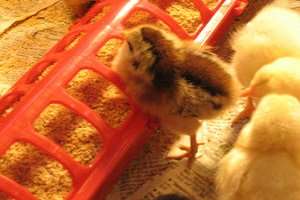By Matthew Benson
How To Take Care Of Baby Chicks
Rodale’s Organic Life
Caring for a few backyard chickens is rewarding – both in eggs and time well spent, as well as the enjoyment of working with an animal. And unless you know your farmer personally, it is the only way to ensure the hens who lay your eggs are treated as you expect them to be.

Raising backyard chickens can be really rewarding, especially when starting from scratch.
If ever there were a path to instant farm cred—a fallback to hopping up on your straw bale and shouting, “Hey, I’m farming here!”—chickens might be it. And knowing what we know about the wing-on-wing crowding and misery of most poultry farms, keeping a few contented chickens makes a lot of karmic sense (before you get your own, look at the Expectations Versus Reality Of Owning Chickens). We eat with our eyes and minds as much as we do with our tongues, and the sight of a small flock of freely ranging hens clucking about the property, happily creating delicious eggs, is an ongoing delight.
Whether you allow them to range free or keep them in a coop and run, caring for backyard chickens is relatively easy. As long as they have access to clean water, food, shade, and shelter, they’ll go about their business without much fuss. The rewards of caring for your own feathered flock are many, and you may find yourself bonding with your birds as you would with any other pet. Their insatiable curiosity and amusing social habits are always entertaining. Besides all their bug-eating and egg-laying benefits, chickens are just plain fun to have around.
Be sure to check local ordinances before you decide to raise a backyard flock. Some towns and municipalities don’t allow chickens, while others restrict the size of the flock and whether roosters are permitted. You may also want to let your neighbors know, appeasing any concerns with the promise of fresh, organic eggs.
Chicks should be ordered in early spring. They can be bought either at the local farm supply store or from catalogs and online suppliers. Ordering online has the advantage of variety, although most hatcheries require you to order a minimum of 25 chicks, as they come cheeping in the U.S. mail, huddled together for warmth. The least expensive orders are straight runs, which are usually half roosters, half hens. Since a flock needs only one rooster to produce fertile eggs, a “sexed” run of all females and one male is best. If you just want a laying flock and don’t plan on breeding chicks (or if roosters would unnerve the neighbors), order a sexed run of only females.
Your baby chicks will need close attention and care for the first few weeks, so be sure your schedule fits theirs. It’s important to have your brooder box set up before you order. This is an enclosed space for day-old chicks with a water fountain, feeder, and heat lamp. It can be as simple as a large cardboard box with wood shavings or paper towels as bedding, but be sure to change the bedding regularly. The brooder box needs to be draft free and placed somewhere in the house or garage where it can be checked on easily at least a half-dozen times a day (although chicks are so adorably fuzzy and cute you may find that they monopolize your time!).
Baby chicks need a steady heat source for the first few weeks of their lives: 95 degrees for the first week, 90 degrees for the second, and so on, reducing the temperature by 5 degrees each week. Keep a thermometer in the brooder to monitor the heat. Extremes in either direction could be fatal. An infrared lamp (250 watts) is a good heat source, and its red spectrum is less disruptive than white light.
Click here to see more...